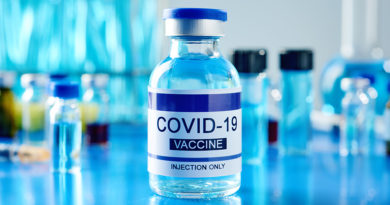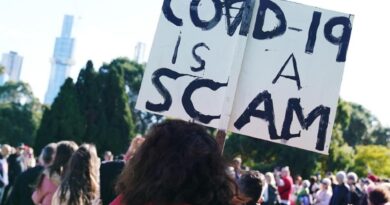Covid: Fauci Says He’d Wear a Mask in Places With Low Vaccination Rates
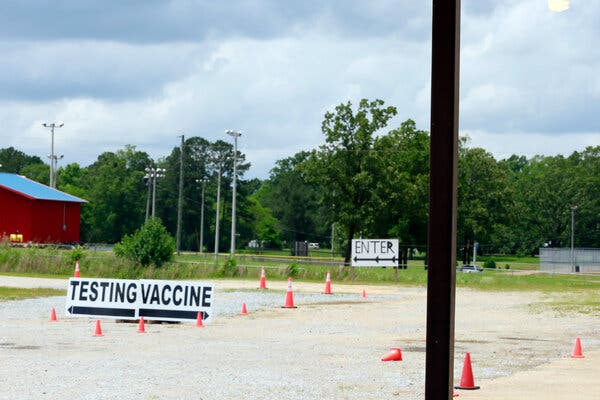
If Dr. Anthony S. Fauci, the director of the National Institute of Allergy and Infectious Diseases, were right now in, say, Biloxi, Miss., he would consider wearing a mask.
Dr. Fauci is fully vaccinated. But on Sunday in an interview on NBC’s “Meet the Press,” he told anchor Chuck Todd that in parts of the country with low levels of vaccination and rising coronavirus caseloads, he might “go the extra mile to be cautious enough to make sure that I get the extra added level of protection.”
“Even though the vaccines themselves are highly effective,” he added. Just 36 percent of Mississippi residents have had at least one shot of a coronavirus vaccine.
Whether and when vaccinated people should wear masks is a question that’s been on the minds of many Americans. The Centers for Disease Control and Prevention announced in May that fully vaccinated people did not need to wear masks, even indoors, and has stuck with the guidance.
But worried about the spread of the contagious Delta variant, health officials in Los Angeles County have begun recommending that vaccinated residents wear masks in some settings. And the World Health Organization recently reiterated its advice that all people continue to wear masks and take precautions.
Though about 67 percent of Americans 18 and older have gotten at least one dose of a vaccine and almost 60 percent are fully vaccinated, vaccination rates vary sharply by region. “We’re going to see, and I’ve said, almost two types of Americas,” Dr. Fauci said on Sunday.
On July 1, The White House announced it would send out “surge response teams” with additional testing supplies and therapeutics to communities experiencing a rise in Covid-19 cases. Missouri, where the daily number of reported cases has recently doubled, requested a response team just hours after the announcement. Vaccinations in that state, too, have lagged the national average, at 45 percent.
Dr. Fauci said that 99.2 percent of Covid-related deaths in June occurred among unvaccinated people. “It’s really sad and tragic that most of all of these are avoidable and preventable,” he said.
Dr. Scott Gottlieb, the former commissioner of the Food and Drug Administration, on Sunday predicted 85 percent of the population might end up with some level of immunity to the coronavirus, citing the high transmissibility of the Delta variant.
“We now have our choice in terms of how we acquire that immunity,” Dr. Gottlieb said in an interview on CBS’s “Face the Nation.” “You can acquire it through vaccination or you’re going to end up acquiring it through natural infection.”
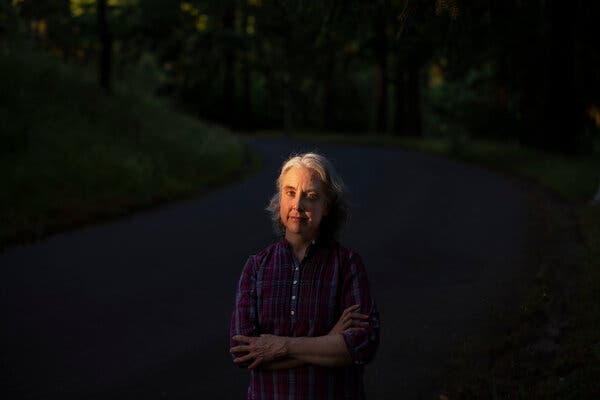
Since April, health care providers in France have routinely given a third dose of a two-dose vaccine to people with certain immune conditions. The number of organ transplant recipients who had antibodies increased to 68 percent four weeks after the third dose from 40 percent after the second dose, one team of French researchers recently reported.
But in the United States, there is no concerted effort by federal agencies or vaccine manufacturers to test this approach, leaving people with low immunity with more questions than answers.
The Centers for Disease Control and Prevention, the Food and Drug Administration, and the National Institutes of Health in fact recommend even against testing to find out who is protected. And academic scientists are stymied by the rules that limit access to the vaccines.
“There should be already a national study looking at post-transplant patients getting booster shots,” said Dr. Balazs Halmos, an oncologist at the Montefiore Medical Center in the Bronx, who led a study showing that some cancer patients did not respond to the vaccines. “It shouldn’t be our little team here in the Bronx trying to figure this out.”
An estimated 5 percent of the population is considered to be immunocompromised. The list of causes is long: some cancers, organ transplants, chronic liver disease, kidney failure and dialysis, and drugs like Rituxan, steroids and methotrexate, which are taken by roughly five million people for disorders from rheumatoid arthritis and psoriasis to some forms of cancer.
“These are the people being left behind,” said Dr. Jose U. Scher, a rheumatologist at NYU Langone Health who led a study of methotrexate’s effect on the vaccines.
The third-dose approach has widespread support among researchers because there is clear precedent. Immunocompromised people are given booster doses of vaccines for hepatitis B and influenza, for example.
Several studies have indicated that a third coronavirus vaccine dose might succeed in patients who did not have detectable antibodies after the first or second dose. But research has lagged.
Moderna is gearing up to test a third dose in 120 organ transplant recipients, and Pfizer — which produces some immunosuppressant medications — is planning a study of 180 adults and 180 children with an immune condition.
The N.I.H. is recruiting 400 immunocompromised people for a trial that would track their levels of antibodies and immune cells for up to 24 months, but has no trials looking at a third dose.
“It takes time, unfortunately, especially as a government agency,” said Emily Ricotta, an epidemiologist at the National Institute of Allergy and Infectious Diseases. “We have to go through a lot of regulatory and approval processes to do these sorts of projects.”
President Biden on Sunday said that getting vaccinated was “the most patriotic thing” that Americans could do in remarks addressed to a crowd attending a Fourth of July party on the South Lawn of the White House, and broadcast nationally. He said that the United States was emerging from the darkness of the pandemic but also stressed that the country was not clear of the pandemic, and singled out the Delta virus variant as a threat.
Mr. Biden had hoped to turn the Fourth of July into a celebration not just of the nation’s independence, but of reaching his administration’s ambitious goal to have 70 percent of adults at least partly inoculated against the coronavirus before the holiday.
He didn’t quite make it. As of Friday, only about 67 percent of Americans 18 and older had gotten at least one dose of a vaccine, according to a New York Times tracker. Almost 60 percent of all adults were fully vaccinated, and the highly contagious Delta variant was creating hot spots, particularly in states with low vaccination rates, like Missouri.
The shortfall has not dampened the White House’s outlook. The president has pressed ahead with an optimistic message, signaling that this year’s July Fourth celebration will be about “independence from the virus” and a return to some semblance of normal life.
On Saturday, Mr. Biden visited Traverse City, Mich., as part of what the White House called the “America’s Back Together” celebration. On Sunday, he and his wife, Jill Biden, hosted a party whose invitation list included 1,000 military personnel and essential workers, on whom Mr. Biden lavished thanks during his speech.
A sense of a new day seems to be shared by many Americans, who have returned to prepandemic Fourth of July rituals in droves, flocking to the roads and to the skies in the stiffest test yet for the nation’s travel infrastructure since it was mostly shut down by the pandemic in March 2020.
The Transportation Security Administration screened 2.197 million people on July 3, the most since March 5, 2020, about a week before the World Health Organization declared a pandemic.
Despite the new variant’s spread, reports of new cases across the country have been holding steady at 12,000 a day, the lowest since testing became widely available. The U.S. average of fewer than 300 daily deaths from Covid-19 is a decline of 23 percent over the past two weeks. Hospitalizations are also dropping.
Some public health experts cautioned, however, that scenes of celebrations might send the wrong message when wide swaths of the population remain vulnerable.
The continuing threat of the virus was brought into sharp focus on Saturday, when the authorities announced that six emergency medical workers helping with rescue efforts at the site of a collapsed condo in Surfside, Fla., had tested positive.
On Friday, Mr. Biden urged those who have yet to get vaccinated to “think about their family” and get a shot as the Delta variant spreads.
“I am concerned that people who have not gotten vaccinated have the capacity to catch the variant and spread the variant to other people who have not been vaccinated,” he said. “Don’t just think about yourself. Think about your family.”
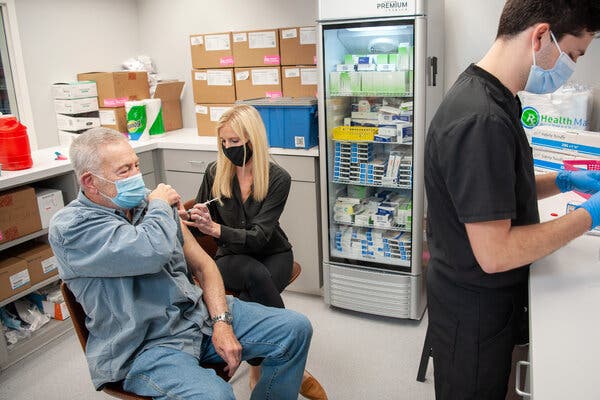
Gov. Asa Hutchinson of Arkansas said on Sunday that his state’s vaccination campaign was falling behind because of young people’s hesitancy to get the shot, a problem that has been plaguing the nation.
“We’ve done very well in our senior citizens, 65 plus, getting vaccinated, our nursing home residents and staff,” Mr. Hutchinson said on Sunday on CNN’s “State of the Union.” “But it is our younger adults now getting hit with the Delta variant, which is more contagious.”
About 42 percent of residents have received at least one shot in Arkansas, and 34 percent are fully vaccinated. Cases are still relatively low, with a seven-day average of 475 new infections reported as of Saturday, according to a New York Times database. But daily infections have increased over the past few weeks, more than doubling.
The state will prioritize making the vaccines readily available, Mr. Hutchinson said. At a Fourth of July concert in Little Rock, for example, a pop-up clinic would offer shots to people celebrating the holiday.
Still, Mr. Hutchinson said he didn’t think a harsh third wave of infections is likely in Arkansas.
“I think our vaccination rate is sufficient that we can avoid the surge in hospitalizations that puts us in jeopardy,” he said. Still, he added, “If we stopped right here and didn’t get a greater percentage of our population vaccinated, then we’re going to have trouble in the next school year and in the winter.”
Southern states have seen reduced vaccination rates, compared with the rest of the nation, but all over the country, the initial rush to vaccination sites has slowed. Vaccine hesitancy remains high among conservatives, evangelicals and some minority groups.
Mr. Hutchinson said that after sending forth trusted messengers to urge residents to get vaccinated, the state’s next step would be to work with employers to make sure vaccinations are easy for workers to schedule.
“The employers have an opportunity to make it accessible for them, give them paid time off, so they can go get vaccination and encourage them with the right level of education and information,” Mr. Hutchinson said.
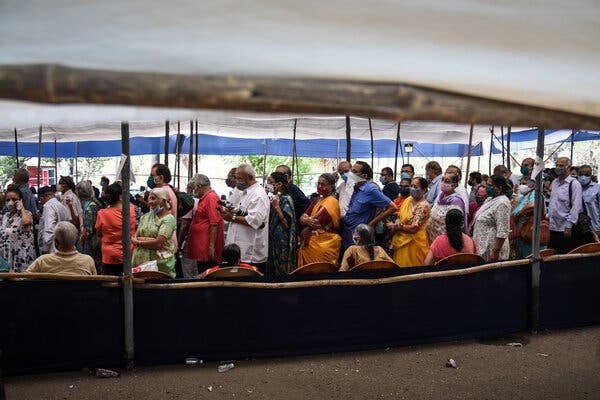
As India intensifies its vaccination effort amid fears of another wave of the coronavirus, officials are investigating allegations that perhaps thousands of people were injected with fake vaccines in the financial capital, Mumbai.
The police have arrested 14 people on suspicion of involvement in a scheme that administered injections of salt water instead of vaccine doses at nearly a dozen private vaccination sites in Mumbai over the past two months. The organizers, including medical professionals, allegedly charged between $10 and $17 per dose, according to the authorities, who said they had confiscated more than $20,000 from the suspects.
“Those arrested are charged under criminal conspiracy, cheating and forgery,” said Vishal Thakur, a police officer in Mumbai.
More than 2,600 people came to the camps to receive shots of the Oxford-AstraZeneca vaccine, manufactured and marketed in India as Covishield. Some said that they became suspicious when their shots did not show up in the Indian government’s online portal tracking vaccinations, and when the hospitals that the organizers had claimed to be affiliated with did not match the names on the vaccination certificates they received.
“There are doubts about whether we were actually given Covishield or was it just glucose or expired/waste vaccines,” Neha Alshi, who said she was a victim of the scam, wrote on Twitter.
Siddharth Chandrashekhar, a lawyer who has filed a public interest lawsuit in Mumbai’s high court, described the scenario as “heartbreaking.” The court said it was “really shocking that incidents of fake vaccination are on the rise.”
Medical scams are nothing new in India, where, during the country’s mammoth outbreak this spring, profiteers targeted vulnerable Covid patients with fake drugs and oxygen. The police in West Bengal state are also investigating whether hundreds of people, including a local lawmaker, received fake vaccines there.
India has administered more than 340 million vaccine doses, but less than 5 percent of the population is fully vaccinated, according to the Our World in Data project at the University of Oxford. The country is reporting nearly 50,000 new cases daily and nearly 1,000 Covid deaths, numbers that are far lower than two months ago, although experts have always believed India’s official tallies to be vastly undercounted.
On Saturday, the pharmaceutical company Bharat Biotech reported that its Covaxin shot — the other vaccine in wide use in India — was 77.8 percent effective in preventing symptomatic illness, according to the results of a late-stage trial. Those results were published online but have not been peer-reviewed.
The report said that the vaccine prevented severe Covid in 93.4 percent of cases and was also effective against the Delta variant, preventing infection in 65.2 percent of cases.
There have been lingering doubts about the vaccine, which was approved by the Indian government in January and administered to millions before it had been publicly proved to be safe or effective.
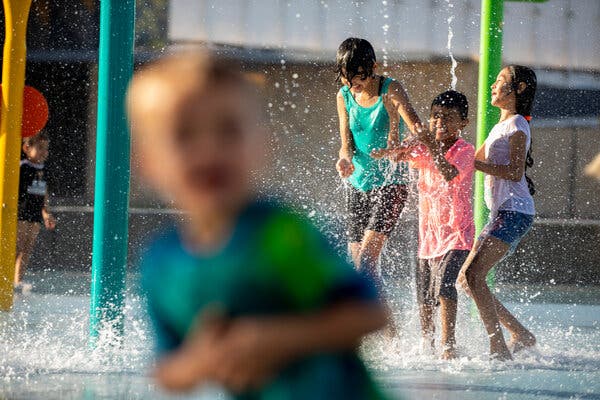
In the United States, a weekend of barbecues and Independence Day parades means that there will be many children under 12, who are sill not eligible to be vaccinated, mixing with people of all ages who may or may not be fully vaccinated.
Since the highly transmissible Delta variant is spreading, and only full vaccination offers significant protection from it, here is some basic advice for parents on how to navigate public areas with unvaccinated children, from The Morning Newsletter.
But first, some perspective. In England, where Delta is already widespread, Covid-related hospitalizations of children have risen from their lows of a few weeks ago, but the increases are not large. So the best assumption seems to be that Delta will be modestly worse for children than earlier versions of the virus. “I haven’t seen data to make me particularly worried about Delta in kids,” Jennifer Nuzzo, a Johns Hopkins epidemiologist, said.
And Dr. Robert Wachter of the University of California, San Francisco, said this of the coronavirus and children: “The actual overall threat of death is minuscule, and the threat to health is quite low, but if I had young kids, I’d still really prefer they not get Covid.”
-
Unvaccinated children, like adults who are not fully vaccinated, should wear masks indoors and avoiding crowded places.
-
Take special care in areas with the lowest vaccination rates, which tend to be in the Southeast and the Mountain West. “If I were living in a place where cases were rising, I’d be more worried that my children could contract Covid,” said Jennifer Nuzzo, a Johns Hopkins epidemiologist.
-
The biggest risk to your child’s health today almost certainly is not Covid. It’s more likely to be an activity that you have long decided is acceptable — like swimming, riding a bicycle or traveling in a car. So exercise caution.
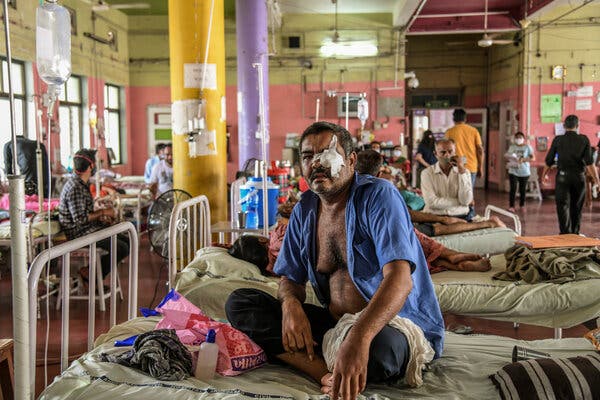
At least three cases of the deadly black fungus disease have been recorded in Afghanistan, including one leading to a death at a hospital in the capital, Kabul, public health officials said.
The disease, mucormycosis, is rare in the United States and Europe but has already infected tens of thousands in India, likely because of unsanitary hospital conditions. It is fatal in over 50 percent of cases. The fungus eats bone and tissue, often spreads to the eye socket and brain, and requires disfiguring surgery.
In addition to the death earlier this week of a 31-year-old man in Kabul, two cases are being treated in Afghanistan, a health ministry spokesman said on Saturday. Covid-19 infections have apparently played a role, as they did in India: All three were Covid sufferers.
In India, where oxygen is in short supply, doctors have liberally prescribed steroids to aid Covid sufferers’ breathing. Often these prescriptions exceed, by far, recommend doses, weakening patients’ immune systems and leaving them more vulnerable to the deadly fungus.
Diabetics are also vulnerable because steroids increase blood sugar levels. It is not known if the Afghan patients had diabetes. But it is likely that the official figures for the disease so far seriously underreport its incidence. This has been the case with Covid, in a country with little capacity for accurate health reporting.
Last month, black fungus cases in India shot up to more than 30,000 from low numbers, and over 2,000 deaths were recorded. Mucormycosis develops from spore buildups in homes and hospitals. India typically records some 50 of these infections a year, compared with a mere handful in the West.
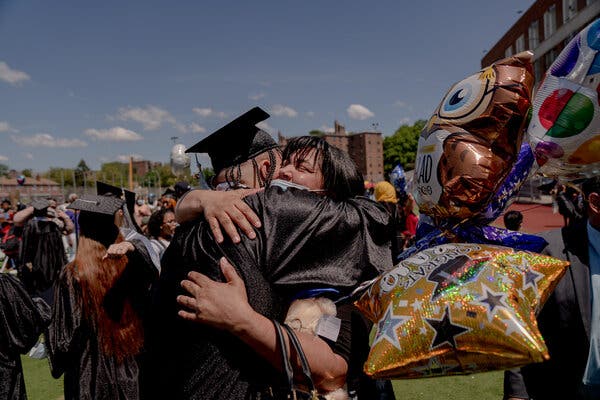
As New York has reopened after more than a year of coronavirus restrictions, students across the city in the last few weeks have celebrated the end of a school year unlike any other. In-person graduation ceremonies have returned for the first time since 2019, marking what students and teachers hope will be the beginning of a return to normal life.
Members of the graduating class of Bronxdale High School were treated like local celebrities as they stepped onto the lavishly decorated football field for their ceremony last month.
Friends and family behaved like paparazzi, waving and instructing the masked graduates to look their way so they could take the perfect picture. Parents, siblings and other supporters made loud declarations, sometimes with a bullhorn, saying, “That’s my baby!” and “We’re so proud of you!” as the graduates made their way to their seats.
For some it was a bittersweet moment. A few days after her grandmother died of Covid-19 in April, Akayla Green, 18, found out that she had gotten into Cornell University on a full scholarship. Soon after that, she learned she would be this year’s valedictorian.
“I knew that I was doing well in classes, but I just assumed other students were doing better just because they were more on top of their work and turning it in on time, and I was struggling with that at moments,” she said.
Her mother, Kerri Ann Brown Lyons, 44, beamed, and said: “For me to be here today seeing that she got a full ride to Cornell, it’s amazing.”
TRAVEL DISPATCH
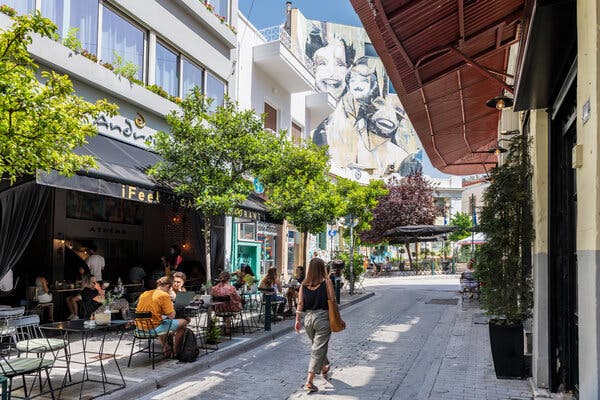
On May 14, Greece officially opened its doors to vaccinated and coronavirus-negative visitors from much of the world, including the United States.
In doing so, the country jumped ahead of a broader European Union reopening at a time when cases remained high and more than three-quarters of the Greek populace was still unvaccinated. It was a gamble Greece couldn’t afford not to make, after seeing its economy shrink a staggering 8.2 percent in 2020. The country welcomed only 7.4 million visitors last year, compared with 34 million in 2019, when travel and tourism accounted for more than 20 percent of Greece’s economic output.
“It’s beyond wanting. We need the people to come back,” said Chara Lianou, an Athenian with dyed-lilac hair and matching acrylics who was serving coffee at Kafeneion 111 in the neighborhood of Monastiraki, part of Athens’s Old Town. “The economy needs it, and going back to work, you feel like you are doing something. The communication with the people, even the bad ones, they make my day,” she said.
*** This article has been archived for your research. The original version from The New York Times can be found here ***
